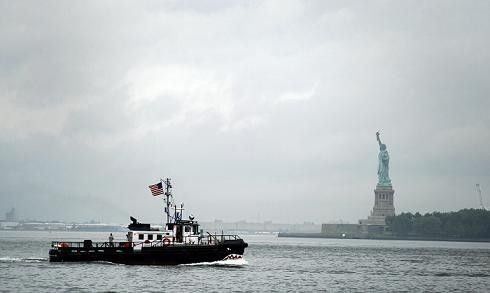Ferocious Hurricane Irene Batters New York

Hurricane Irene battered New York with ferocious winds and driving rain on Sunday, shutting down the U.S. financial capital and most populous city, halting mass transit and causing massive power blackouts as it churned slowly northward along the eastern seaboard.
New York City's normally bustling streets were eerily quiet after authorities ordered tens of thousands of residents to evacuate low-lying areas and shut down its subways, airports and buses.
Those who had to travel were left trying to flag down yellow taxis that patrolled largely deserted streets.
Irene, still a menacing 480-mile (780-km)-wide hurricane, was enveloping major towns and cities in the northeast, hugging the Atlantic coast and threatening dangerous floods and surging tides.
From the Carolinas to Maine, tens of millions of people were in the path of Irene, which howled ashore in North Carolina at daybreak on Saturday, dumping torrential rain, felling trees and knocking out power.
The edge of the hurricane has finally got upon us, New York Mayor Michael Bloomberg told the more than eight million people who live in New York as he warned that tropical storm-force winds would hit the city.
Times Square, often called the crossroads of the world, was sparsely populated, mostly with visitors, as Irene rolled into the city with full force.
Broadway shows were canceled, coffee was hard to come by with Starbucks stores closed and burgers and fries were in short supply as McDonald's outlets were shut.
We just came to see how few people are in Times Square and then we're going back, said Cheryl Gibson, who was vacationing in the city.
Bloomberg warned New Yorkers Irene was a life-threatening storm and urged them to stay indoors to avoid flying debris, flooding or the risk of being electrocuted by downed power lines. It is dangerous out there, he said, but added later:
New York is the greatest city in the world and we will weather this storm.
Some 370,000 city residents were ordered to leave their homes in low-lying areas, many of them in parts of the boroughs of Brooklyn, Queens and Manhattan.
Many were unwilling to go. Nicholas Vigliotti, 24, an auditor who lives in a high-rise building along the Brooklyn waterfront, said he saw no point. Even if there was a flood, I live on the fifth floor, he said.
STORM SURGE FEARS
Flood waters forced officials in Hoboken, just across the Hudson River from Manhattan, to evacuate a storm shelter, the mayor of Hoboken, Dawn Zimmer, said on Twitter.
Hoboken faces worst case scenario. Flooding has begun. Moving Wallace Shelter residents to state shelter in east Rutherford, the mayor's tweet said.
The Miami-based U.S. National Hurricane Center forecast a storm surge of up to 8 feet for Long Island and metropolitan New York. That could top the flood walls protecting the south end of Manhattan if it comes at high tide around 8 a.m. (noon GMT).
With winds of 8O miles per hour (130 km per hour), Irene was a Category 1 hurricane on the five-step Saffir-Simpson intensity scale. By 2 a.m., the center of the storm was 15 miles south southwest of Ocean City, Maryland, and 195 miles south southwest of New York City.
As it moved into New York, the hurricane center said it was expected to remain a hurricane and weaken only after making landfall again in New England.
Boston's public transit authority, the MBTA, said on its website it will shut down all services as of 8 a.m./noon GMT. After that time, all modes of transit will be shut down for the remainder of the day and night, it said.
Summer vacationers fled beach towns and resort islands. More than a million people left the New Jersey shore and glitzy Atlantic City casinos were dark and empty.
This year has been one of the most extreme for weather in U.S. history, with $35 billion in losses so far from floods, tornadoes and heat waves.
NINE DEATHS REPORTED
President Barack Obama, who cut his vacation short on the Massachusetts island of Martha's Vineyard to return to the White House, was keeping a close eye on preparations for the hurricane.
After moving across North Carolina with less punch than expected but still threatening, the hurricane re-emerged over inshore waters on its route northward, hugging the coast.
At least nine deaths were reported in North Carolina, Virginia and Florida. Several million people were under evacuation orders on the U.S. East Coast.
Irene left several million people without power in North Carolina, Virginia, Maryland and Delaware. About 32,000 customers faced outages in New York City, but power Consolidated Edison warned that downtown Manhattan, including Wall Street, could face further blackouts as low lying areas flooded.
When Irene hit the North Carolina coast at daybreak on Saturday, winds howled through power lines, sheets of rain fell and streets were flooded or littered with tree branches.
Hundreds of thousands of people in Irene's path evacuated their homes, many taking refuge in official shelters.
Things can be replaced, but life can't be, said Robert Hudson, a 64-year-old military retiree, who sought refuge at a shelter in Milford High School in Delaware.
North Carolina Governor Bev Perdue said there may be a major hit to tobacco crops, poultry and livestock in her state.
Shoppers stripped supermarkets and hardware stores of food, water, flashlights, batteries and generators.
Torrential rain hit Washington but expected high winds had not hit the city by the early hours of Sunday.
Irene was the first hurricane to hit the U.S. mainland since Ike pounded Texas in 2008. Emergency workers were mindful of Hurricane Katrina, which swamped New Orleans, killed up to 1,800 people and caused $80 billion in damage in 2005.
© Copyright Thomson Reuters 2024. All rights reserved.





















